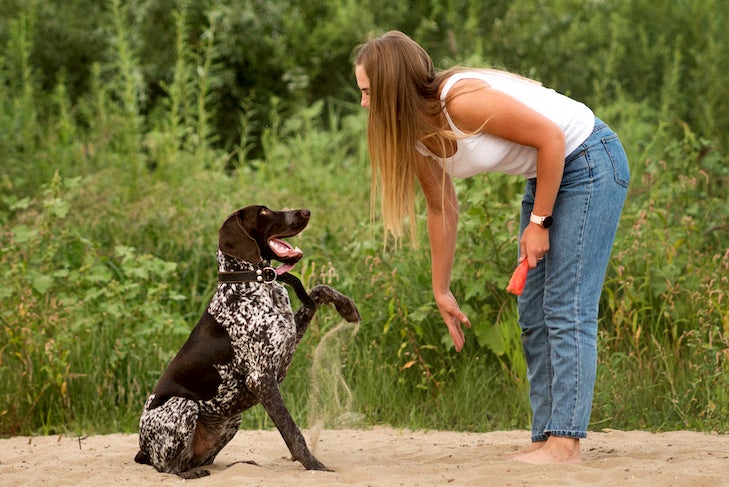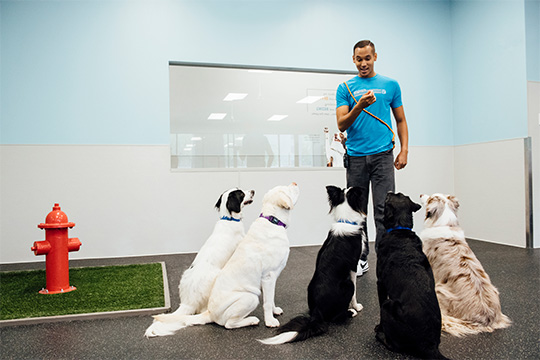Positive Reinforcement in Dog Training: A Humane Approach to Success
Positive Reinforcement in Dog Training: A Humane Approach to Success
Blog Article
Top Dog Training Methods Every Owner Should Know

Favorable Support Methods
Utilizing positive reinforcement strategies is important for effective dog training, as it promotes a relying on bond between the pet and the fitness instructor. This approach concentrates on satisfying desirable actions instead of penalizing undesirable ones, producing a setting favorable to discovering. Incentives can include treats, praise, or play, which motivate dogs to repeat the behaviors that gain them these incentives.

Additionally, this method boosts the dog's interest for training sessions. They are extra engaged and responsive when dogs associate training with positive experiences. Dog training. Past prompt behavior adjustment, favorable support encourages a collaborative connection in between the canine and fitness instructor, lowering anxiety and worry
To maximize efficiency, it is vital to supply incentives without delay, guaranteeing the canine links the habits with the reinforcement. In essence, positive reinforcement techniques not only yield better-trained canines but also promote a harmonious partnership in between pet and owner.
Remote Control Training Approach
The clicker training technique is a highly efficient method that builds on the principles of positive support by adding a distinct sound to mark desired behaviors. This approach makes use of a small portable device that produces a clicking audio, permitting fitness instructors to interact with their dogs in a clear and instant manner. When a pet does a behavior that the proprietor desires to urge, the remote control is activated, followed by an incentive, typically in the form of treats or appreciation.
The trick to successful clicker training exists in uniformity and timing. It is important to click at the specific moment the preferred habits occurs, making sure that the pet associates the audio with the action and the succeeding reward. This method not just improves interaction however also cultivates a stronger bond between the dog and the owner, as it encourages involvement and communication throughout training sessions.
Clicker training can be used to a range of actions and commands, from basic obedience to extra complicated tricks. Its versatility and effectiveness make it a favored method amongst expert fitness instructors and pet dog proprietors alike, leading the way for a well-trained and receptive canine companion.
Leash Training Essentials
Efficient leash training is necessary for ensuring a risk-free and enjoyable strolling experience for both pets and their owners. A level collar might work for some canines, while others may benefit from a harness that minimizes drawing.
Present your canine to the leash gradually, enabling them to discover it in a comfy environment. Once they are accustomed, method loose-leash walking. This includes satisfying your dog for strolling beside you instead of drawing ahead. Use treats and praise to reinforce preferred behavior, and be certain to stay tranquil and assertive.
If your pet dog starts to draw, stop strolling quickly. Furthermore, method various strolling environments to assist your pet dog adjust to interruptions.
Routine technique will strengthen your canine's understanding of leash rules. Bear in mind that leash training is a recurring procedure; persistence and uniformity will produce the finest outcomes, promoting a favorable experience for both you and your canine friend.
Socialization Approaches
Socializing is a crucial facet of pet training that must ideally start during puppyhood yet can be helpful at any age. Efficient socialization assists canines check here create self-confidence and decreases the chance of behavior problems. To implement effective socialization strategies, expose your pet dog to a selection of atmospheres, people, and other animals.
Begin with controlled setups, such as pup classes or arranged playgroups, where young dogs can connect securely. Slowly introduce your canine to new experiences, including different noises, surfaces, and tasks. Make certain these experiences are positive and rewarding to establish a complacency.
For adult pets or those lacking exposure, start with low-stress scenarios. Short, positive interactions with pleasant human beings and tranquil pets can create favorable associations. Utilize treats and appreciation to enhance preferable behaviors during these experiences.

Uniformity and Persistence
Identifying the significance of uniformity and persistence in dog training is necessary for accomplishing lasting outcomes. Inconsistent training can lead to confusion, making it hard for the canine to realize commands or habits, eventually preventing development.
Additionally, perseverance is a vital part of effective training. Pets, like humans, learn at their own rate. Some might grasp principles quickly, while others might take longer. It is crucial for proprietors to remain calm and helpful, enhancing positive behavior without resorting to frustration or punishment. This fosters a trusting connection between the pet dog and proprietor, encouraging an extra willing and enthusiastic student.
To grow uniformity and persistence, develop a regular training regular, utilize the exact same commands, and make certain that all member of the family use the exact same training concepts - Dog training. By doing so, you produce a steady setting for learning, permitting your pet to create and prosper into a well-behaved friend
Verdict
Finally, reliable dog training strategies, such go to these guys as positive support, remote control training, and correct chain training, are essential for promoting a healthy owner-dog relationship. Additionally, implementing socialization techniques and keeping uniformity and persistence throughout the training procedure contributes substantially to a canine's general well-being. By incorporating these approaches, pet proprietors can facilitate the growth of well-adjusted, obedient pet dogs, ultimately improving the lifestyle for both the proprietor and the dog.
Amongst the most prominent techniques are favorable reinforcement, clicker training, and leash training, each offering unique benefits that contribute to a well-behaved pet dog. As we discover these essential methods, it becomes evident that mastering their subtleties can substantially affect the training experience and the pet dog's total actions.Using favorable reinforcement techniques is necessary for efficient canine training, as it promotes a trusting bond between the pet and the trainer.In conclusion, efficient pet dog training techniques, such as positive reinforcement, remote control training, and proper chain training, are necessary for fostering a healthy and balanced owner-dog partnership. By incorporating these methods, canine proprietors can facilitate the advancement of well-adjusted, obedient pet dogs, ultimately enhancing the high quality of life for both the pet and the owner.
Report this page